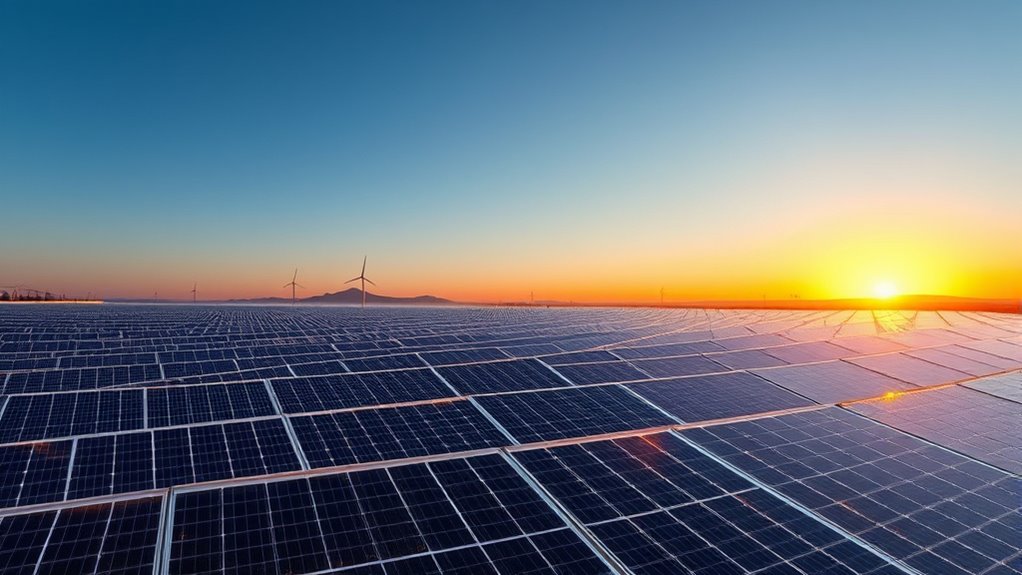The future of solar looks bright thanks to innovations in photovoltaic technology. Researchers are improving efficiency with multi-junction and emerging materials like perovskites, which are cheaper and more versatile. New designs and nanotechnology boost performance and adaptability, making solar panels more durable and lightweight. These advancements lower costs and expand applications across residential, commercial, and portable uses. Keep exploring to discover how these breakthroughs will shape a cleaner, more sustainable energy landscape for everyone.
Key Takeaways
- Emerging photovoltaic materials like perovskites promise higher efficiency and lower manufacturing costs.
- Advanced solar panel designs maximize sunlight capture and adapt to diverse environmental conditions.
- Nanotechnology improves light absorption and reduces energy loss, enhancing overall system performance.
- Increased durability and recycling practices ensure sustainable, long-lasting solar energy solutions.
- Innovations accelerate market adoption, making solar technology more affordable, versatile, and accessible globally.

The future of solar energy looks brighter than ever as technological advancements and declining costs make it more accessible worldwide. One of the most exciting developments lies in improving solar cell efficiency, which directly impacts how much sunlight can be converted into usable electricity. Higher efficiency means you can generate more power from the same amount of sunlight, making solar installations more productive and cost-effective. Researchers are constantly pushing the boundaries of photovoltaic materials to achieve this goal. Traditional silicon-based solar cells have dominated the market, but new materials are emerging that promise even better performance. For example, perovskite solar cells are gaining attention because they can be manufactured at lower costs and can achieve higher efficiencies than conventional silicon panels. These materials also open the door to flexible, lightweight solar panels that can be integrated into a variety of surfaces and applications, from building exteriors to portable devices. Additionally, understanding the expiration of different photovoltaic materials is crucial for ensuring long-term performance and safety of solar panels. Advances in material longevity research are helping manufacturers develop more durable panels that withstand environmental stresses over time. Moreover, ongoing research into recycling and disposal of photovoltaic materials ensures sustainable practices as solar technology becomes more widespread. As research progresses, new manufacturing techniques are emerging that lower production costs and improve scalability, making advanced solar technologies more accessible to all.
Innovative designs for solar panels that maximize sunlight capture across various angles and lighting conditions are also developing, driven by ongoing research. Multi-junction solar cells, which combine multiple layers of different photovoltaic materials, can harness a broader spectrum of sunlight, considerably boosting efficiency. This means your solar system can produce more energy throughout the day and in less-than-ideal weather. Advances in nanotechnology are also playing a role, allowing for the development of materials that improve light absorption and reduce energy loss. This progress not only enhances the performance of existing solar panels but also also paves the way for new types with superior durability and adaptability.
Furthermore, as these innovations become more affordable and scalable, you’ll notice increased adoption in residential, commercial, and utility-scale projects. The improved photovoltaic materials and higher solar cell efficiency reduce installation and maintenance costs, making solar energy a more attractive option for a wider audience. Governments and private companies are investing heavily in research, aiming to commercialize these advanced technologies soon. In practical terms, expect to see solar panels that are more efficient, more durable, and more versatile. These improvements will accelerate the transition toward renewable energy, helping decrease reliance on fossil fuels and combat climate change. Ultimately, the ongoing advancements in photovoltaic materials and solar cell efficiency are set to revolutionize how you harness solar power, making it cleaner, cheaper, and more accessible than ever before.
Frequently Asked Questions
How Do Solar Panel Recycling Processes Impact Environmental Sustainability?
You might wonder how solar panel recycling impacts environmental sustainability. Recycling efficiency plays a vital role, allowing you to recover valuable materials and reduce e-waste management issues. When you properly recycle panels, you help minimize hazardous waste and lessen the demand for new resource extraction. This process supports a cleaner environment, curbs pollution, and promotes sustainable energy practices—making recycling a essential step toward a greener, more sustainable future.
What Are the Latest Breakthroughs in Transparent Photovoltaic Materials?
You’re exploring the latest breakthroughs in transparent photovoltaic materials, focusing on innovations like transparent conductors and nanostructured films. These advancements enable solar cells to be more efficient, flexible, and seamlessly integrated into windows and screens. Researchers are developing materials that combine high transparency with excellent conductivity, pushing the boundaries of solar energy harnessing. This progress promises to transform everyday surfaces into energy-generating assets, making solar power more accessible and aesthetically pleasing.
How Will Solar Technology Integration Affect Urban Infrastructure Development?
You’ll see solar technology integration transforming urban infrastructure by seamlessly blending into cityscapes. Urban planning will prioritize building integration, making solar panels a standard feature on rooftops, facades, and windows. This shift encourages sustainable development and reduces reliance on traditional energy sources. As a result, cities become smarter, greener, and more energy-efficient, paving the way for innovative architectural designs that incorporate solar technology into everyday structures.
What Role Do Artificial Intelligence and Machine Learning Play in Solar Efficiency?
Imagine your solar panels as a team of athletes, constantly improving with feedback. That’s how artificial intelligence and machine learning boost solar efficiency. They analyze data through predictive analytics, identifying patterns to optimize energy production. For example, AI can forecast sunlight conditions, adjusting panel angles automatically. This real-time adaptation maximizes output, making your solar system smarter and more efficient—helping you save energy and reduce costs over time.
How Can Solar Innovations Help Reduce Energy Storage Costs Globally?
You can see that solar innovations are key to reducing energy storage costs worldwide. Advanced battery technologies, like solid-state batteries, improve storage capacity and lifespan, cutting expenses. Additionally, smarter energy management systems optimize storage use, minimizing waste. These innovations make it more affordable to store solar energy, helping you and others rely less on expensive grid power, and accelerating the global shift to cleaner, sustainable energy sources.
Conclusion
As you explore the future of solar, you’ll see innovations that make solar power more efficient and affordable. Did you know that solar technology has doubled its efficiency in just the past decade? With advancements like perovskite cells and flexible panels, you have the power to contribute to a cleaner planet. Embrace these innovations and be part of the solar revolution—your choices today can lead to a brighter, sustainable tomorrow.









